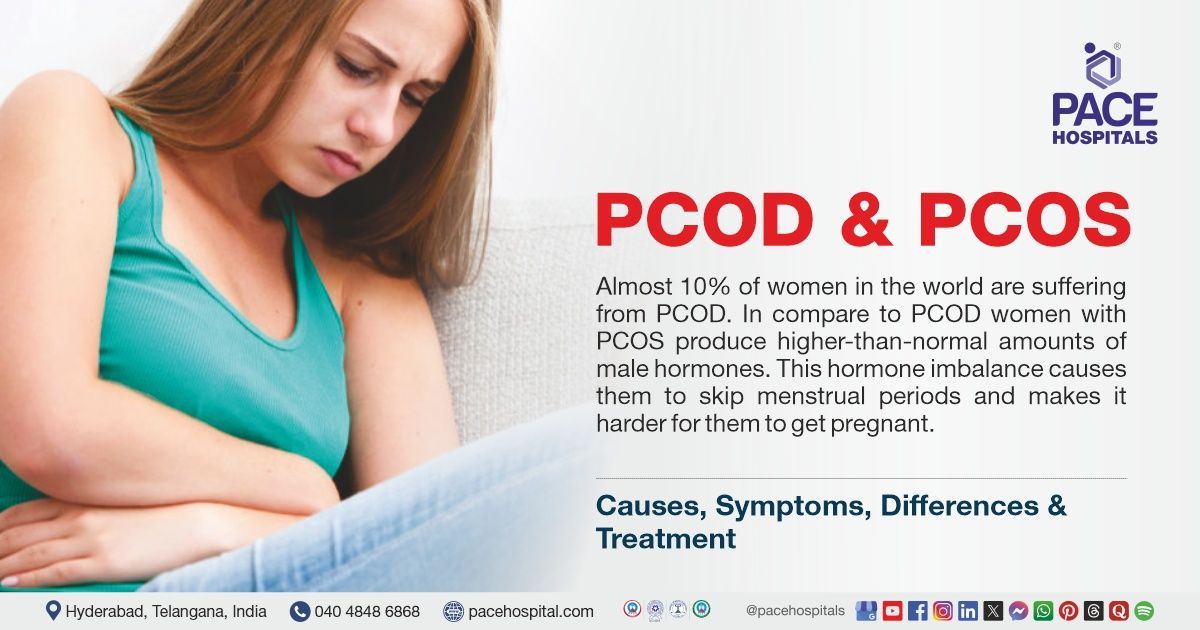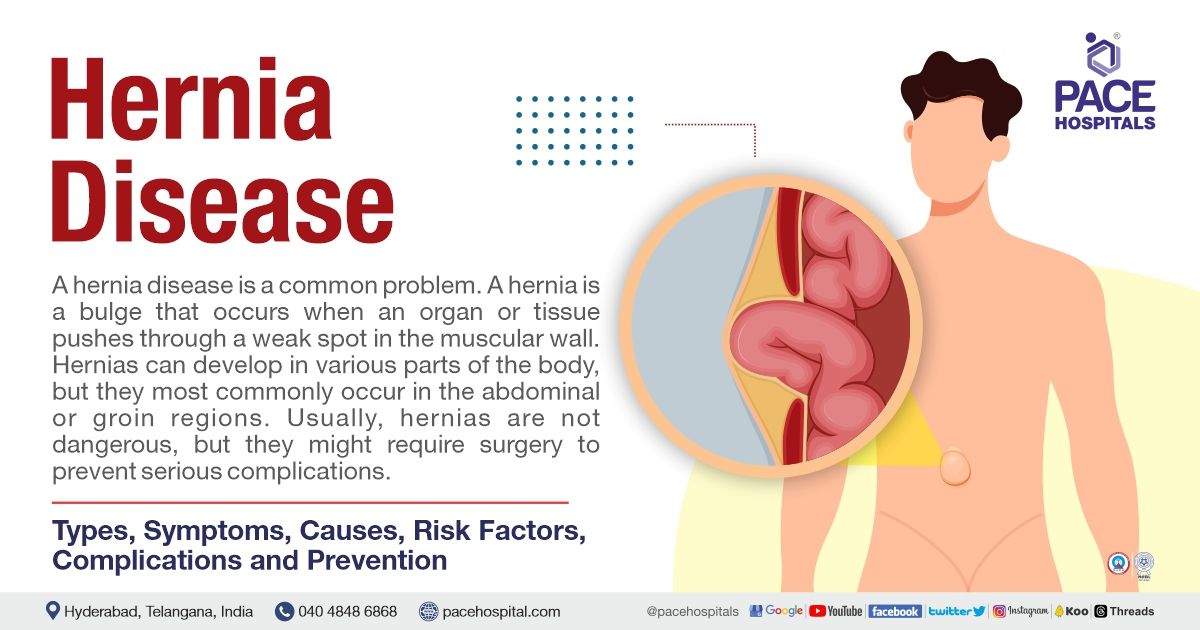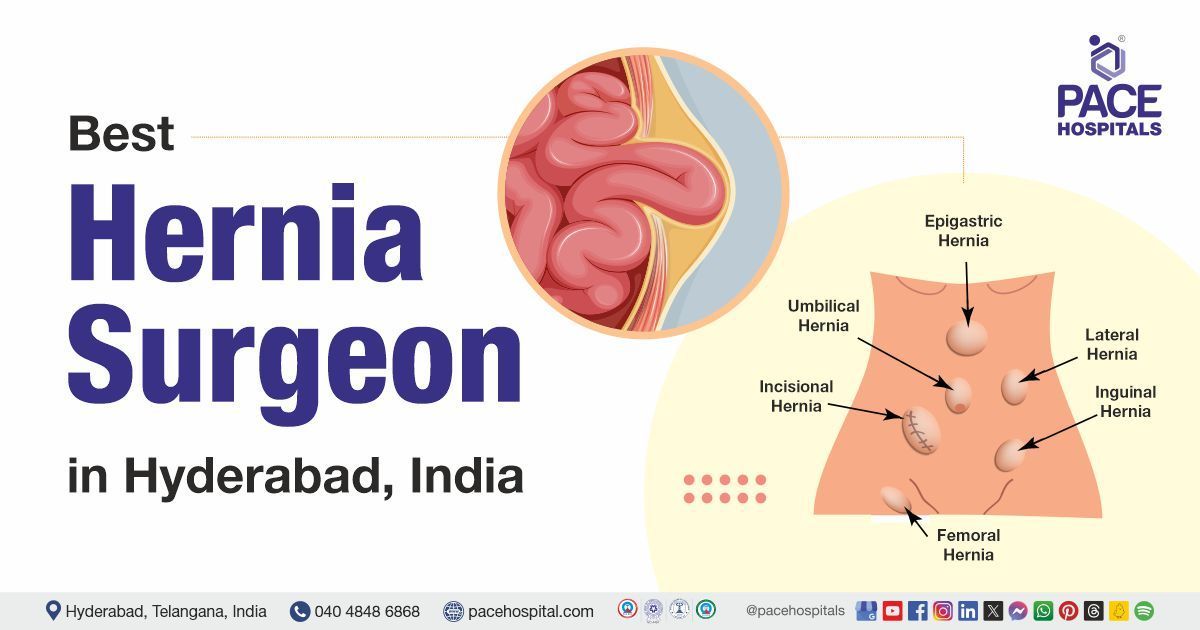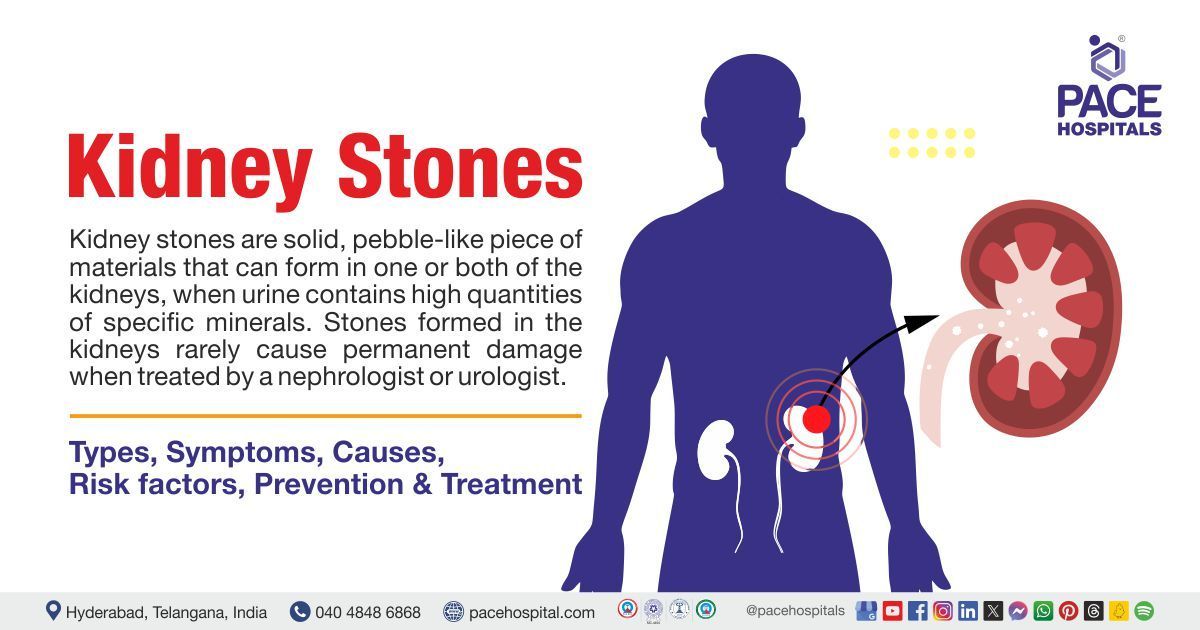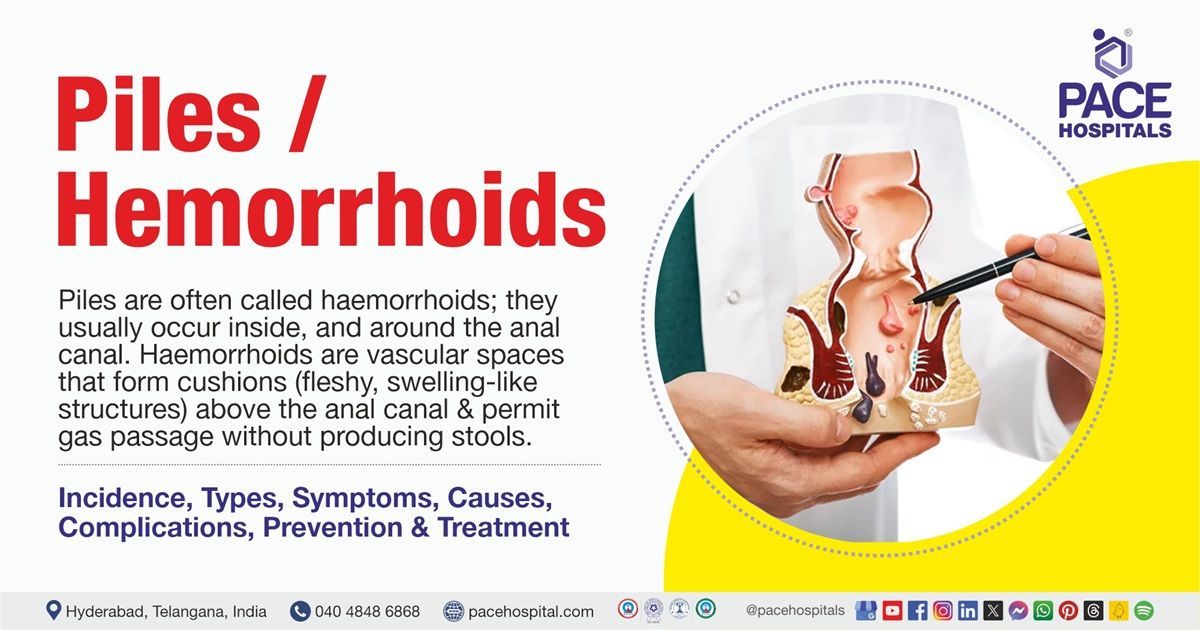Hernia - Symptoms, Types, Causes, Complications, Prevention
Hernia definition
A hernia is a condition characterized by the formation of an abnormal sac through a weak area or hole in the belly region that surrounds the muscle. This condition often results from muscle weakness and strain.
What is a hernia disease?
Hernia meaning
A hernia occurs when the contents of the intestine or abdomen, which are held in place by a muscle or tissue, get pushed through a weak region of the abdomen wall and cavities. Hernia is a sac-like formation that occurs gradually due to strain and muscle weakness, ageing, and regular wear and tear of muscles. Some of the hernias could occur due to injuries and birth defects.
Most of the hernias occur between the chest and hips, and some occur in the thigh or groin regions. Usually, hernias are not dangerous, but they might require surgery to prevent serious complications.
Hernia locations
The common locations or sites where hernias tend to occur are:
- Lower chest through the diaphragm or midline of the abdomen
- Groin region
- Femoral region
- Umbilical region
- Former surgery incisions
Incidence of hernia disease
15%–20% of individuals in the general population have hernias. There are 1.5 to 2 million inguinal hernias in India, according to statistics. Men are more likely than women to have an inguinal hernia. Men undergo about 90% of inguinal hernia procedures, whereas women undergo 70% of femoral hernia repairs. The inguinal hernia has been reported to have a standing risk of 27% in men and 3% in women. Inguinal hernias are five times more frequent than femoral hernias in women, even though femoral hernias are more common in women overall. At the same time, children are most frequently affected by umbilical hernias.
Types of hernia disease
Different types of hernias that tend to occur commonly are as follows:
- Inguinal hernia: An inguinal hernia is often called a groin hernia due to the occurrence of a hernia in the groin area. An inguinal hernia is characterised by the bulging of abdominal contents through the weak regions of the abdominal wall. Groin hernias may happen at two passages, either through the inguinal or femoral canals. Hernia often bulges out through an opening that may be congenital (from birth), often called congenital inguinal hernia or due to muscle degeneration upon ageing.
- Umbilical hernia: A ventral hernia that is present at or close to the umbilicus (navel) is known as an umbilical hernia. An umbilical hernia occurs when fat, tissue, or an organ, typically a portion of the intestine, pushes or bumps through a weak spot in the abdominal wall near the belly button. Usually, an umbilical hernia develops when the layers of the abdominal wall do not fuse at the time of birth ; umbilical hernias aren’t serious and typically don't cause any major health problems.
- Hiatal hernia: Hiatal hernia arises when the upper portion of the stomach pushes up amongst the diaphragm and into the chest area. A major muscle called the diaphragm is located between the chest and abdomen. This muscle aids in breathing for individuals. However, in healthy individuals, the stomach lies below the diaphragm, but in those who have a hiatal hernia, a piece of the stomach pushes up through the muscle and passes through an opening known as a hiatus.
- Incisional hernia: An abdominal wall hernia near the location of a prior surgical incision is referred to as an incisional hernia. Basically, it is a ventral hernia. Incisional hernias most frequently occur in the midline. Any abdominal surgical treatment involving an incision in the abdominal wall may result in an incisional hernia. In addition to this, traumatic abdominal wall injuries have been linked to incisional hernia. Incisional hernias occur when the abdominal wall fails to seal properly after an incision.
- Femoral hernia: A femoral hernia tends to occur near the top of the inner thigh due to the protrusion of the fatty tissue or the portion of the colon into the groin region. It enters a region known as the femoral canal by pushing through the weak spot that is surrounded by the muscle wall.
- Diaphragmatic hernia: A diaphragmatic hernia is a defect that is seen at birth. This defect is characterised by a hole in the diaphragm (the diaphragm is a muscle that distinguishes the chest from the abdomen). In this condition, organs of the abdomen move upwards into the baby's chest through the hole of the diaphragm. This condition leads to the incomplete development of the lungs in the baby, resulting in breathing difficulties.
- Epigastric hernia: Epigastric hernia is a condition characterised by the formation of a bulge or lump in the epigastric region (the epigastrium is the site above the navel and below the breastbone). These hernias are present from birth; however, they are seen in both children and adults. Epigastric hernias vary in size and might occur more than one hernia at a time. Usually, these are small and mostly asymptomatic.
- Spigelian hernia: A Spigelian hernia is a type of ventral hernia that occurs rarely and is characterised by herniation of the peritoneum or abdominal contents through the defect called the spigelian fascia constituting the transversus abdominus and the internal oblique aponeuroses. It is often caused by increased intra-abdominal pressure, trauma, degeneration of the aponeurotic layers with ageing, and collagen abnormalities.
- Obturator hernia: Obturator hernias, which make up less than 0.04% of all hernias, are a rare cause of abdominal pain. When intestinal contents pass through the obturator foramen, an obturator hernia results. There is a higher likelihood that these hernias will become incarcerated and eventually strangle due to the hole in the pelvis.
- Littre hernia: Meckel's diverticulum (MD) is a clinical sign of the uncommon condition known as Littre hernia (LH), which occurs within a hernia sac. The majority of MD cases are asymptomatic despite being the most frequent congenital malformation of the digestive tract. It could, however, show up as a number of difficulties.
Hernia symptoms
Hernia signs and symptoms include:
- Discomfort or pain upon straining, standing, and lifting
- Visible bulge or lump upon straining, lifting, and coughing
- Weakness or pressure in the groin
- Nausea, vomiting, and constipation are seen in strangulation (cessation of blood supply to the hernia)
- Swelling under the skin of the groin or abdomen
- Tenderness (feeling pain upon touch)
Note: The above symptoms are the most common symptoms that are mostly observed in hernia patients. However, there might be some specific uncommon symptoms in hernias, such as hiatal hernias, ventral hernias, diaphragmatic hernias, congenital hernias, etc.
Hernia in men
Inguinal hernias, both direct and indirect, are the most common type of hernia in men. A common site for hernia formation is the inguinal canal, which is more common in men. Men are also more likely to develop femoral hernias. These male hernias can be caused by heavy lifting, chronic coughing, or straining during bowel movements.
Symptoms of hernia in men
- A groin bulge, or a protrusion between the thighs and lower abdomen
- Having a bulge in the scrotum
- Experiencing groin discomfort, pain (aching or dull-like), heaviness, or burning
- Swelling and tenderness
Hernia in women
Women can develop inguinal and femoral hernias, especially during pregnancy or after childbirth, as they are more prone to umbilical hernias. Increased intra-abdominal pressure during pregnancy weakens the abdominal muscles, leading to the formation of a hernia around the belly button.
Hernia symptoms in women
Depending on the nature and location of the hernia, hernia symptoms in women can vary. Inguinal, femoral, umbilical, and incisional hernias constitute the common forms of hernias in women. The following are some typical signs and symptoms of hernias in women:
- A noticeable bulge or enlargement
- Discomfort or pain
- Burden or pressure
- Pain or burning
- Swelling
- Intestinal symptoms
Hernia in children
The most frequent types of hernias in children and infants are inguinal (groin) and umbilical (belly button). Abdominal wall openings are common in newborns and usually close just before or shortly after birth. When these gaps are not sealed, making it possible for the intestines or other organs to pass through, hernias commonly develop in infants and young children. The hernia may appear immediately after birth or years later.
The factors that influence hernia in children are gender, genetics, birth weight, and medical conditions.
Hernia symptoms in children
Symptoms of hernia in children and infants are as follows:
- Unreliable crying or irritability
- A noticeable bulge that enlarges on a cough, weep, or strain
- A bulge or swelling close to the belly button (belly button hernia) or groin (groin hernia)
- Discomfort or soreness
Hernia causes
The causes of hernia disease are as follows:
- Conditions that increase abdominal pressure, such as strenuous activities, heavy lifting, and jobs with long-lasting hours.
- Excessive straining due to chronic cough and constipation.
- Being overweight.
- Frequent or repeated pregnancies.
- Congenital defects such as hip dysplasia, undescended testicles, reproductive or urinary abnormalities, premature birth, cystic fibrosis, etc.
- Environmental or other factors such as poor nutrition and smoking.
- History of abdominal or groin surgeries.
Hernia risk factors
Risk factors for hernia disease are as follows:
- Ageing: An inguinal hernia may occur in persons who are getting older. The lower abdominal wall muscles and connective tissues covering the inguinal canal weaken with age, resulting in the risk of developing a hernia.
- Gender: Men tend to experience inguinal hernias more frequently than women do because men have a wider inguinal canal than women do.
- Hereditary factors or family history: Inguinal hernias have a genetic component, and the genes connected to inguinal hernia susceptibility have also been linked to connective tissue homeostasis.
- Obesity: Patients who are overweight have the risk of developing an umbilical hernia because being overweight increases the pressure on the abdominal wall.
- Chronic constipation: People who strain while constipated may experience increased abdominal pressure and have a greater likelihood of developing hernias.
- Chronic cough: Prolonged or severe coughing adds pressure on the abdominal wall muscles and can result in a hernia.
- Pregnancy (frequent or multiple): As the gravid uterus grows larger during pregnancy, there is an increased risk of developing a hernia as a result of the increased intra-abdominal pressure. Pregnant women may also develop hernias due to hormonal changes.
- Premature birth or premature infants: Inguinal hernias (inguinal scrotal hernia or testicular hernia) occur when the inguinal canal, through which the testicles descend from the belly into the scrotum, fails to close at delivery. This disorder affects 1 to 5% of children and is prevalent in premature newborns.
- History of abdominal or groin surgeries
- Long-term peritoneal dialysis: One of the mechanical side effects of peritoneal dialysis is an abdominal hernia.
- Congenital conditions: Congenital conditions such as cystic fibrosis, undescended testicles, abnormalities of the reproductive system, early delivery, and hip dysplasia might lead to hernia.
- Males who have undergone prostatectomy (the surgical removal of the prostate gland) previously: Men who have had robotic-assisted radial prostatectomy, a prostatectomy procedure, increase the risk of developing an inguinal hernia as a consequence of incontinence.
- Liver cirrhosis with ascites (fluid buildup in the abdomen): Around 20% of patients with liver cirrhosis associated with ascites may be at risk of developing an umbilical hernia because of elevated abdominal fluid accumulation.
- Chronic abdominal distension: Hernias may form in people with chronic abdominal distension, which usually comes from an intestinal obstruction.
Hernia complications
If a hernia is left untreated, it may cause complications such as:
- Strangulation (strangulated hernia): A strangulated hernia no longer receives blood flow. Consequently, the tissue may experience inflammation, infection, and eventually death (tissue necrosis). The medical emergency of strangulation requires rapid medical or surgical care.
- Incarceration (incarcerated hernia): Occurs when a weak point in the abdominal wall allows the hernia's protrusion (and its contents) to become trapped therein. In addition to intense pain, nausea, vomiting, and the inability to urinate, it might lead to bowel obstruction.
- Bowel obstruction (obstructed hernia): The blockage may result from the small intestine becoming stuck and squeezed due to a herniation. This medical condition prevents the person from passing gas or stool, which causes intense stomach discomfort, nausea, and vomiting.
- Pain or pressure due to enlargement of hernia: Hernias can get larger and exert pressure if they are not treated. This disorder causes the scrotum to bulge downward in men, which causes discomfort and oedema.
- Infections: Inadequate blood supply to the abdominal wall might lead to severe pain and infections.
Hernia diagnosis
There are various diagnostic approaches that a gastrosurgeon might suggest to the patient to diagnose the hernia. They are as follows:
- Physical examination and thorough history taking (family, medical and medication histories)
- Performing blood tests for infections
- Barium X-ray
- Endoscopy
- Ultrasonography (USG)
- Computed tomography (CT scan)
- Magnetic resonance imaging (MRI scan) and more
Hernia treatment
There are various treatment approaches for hernia; based on the type or severity of the hernia, the gastrosurgeon might suggest any one of the following approaches:
Hernia treatment without surgery
- Non-surgical treatment approaches for hernia include:
- Wait and watch approach
- Lifestyle modifications such as management of weight, diet (hernia diet), and smoking cessation
- Medications
Hernia surgery or operation
Surgery or operations for hernias are mainly of two types:
Open hernia repair (herniorrhaphy): In open hernia repair, a surgeon makes an incision near the hernia sites and pushes the protruding tissue back into place. The surgeon then reinforces the weakened abdominal wall with stitches and often uses a hernia mesh patch to provide additional support. This procedure is used for both inguinal and incisional hernias; the following procedures are done under open hernia repair.
- Suture repairs, includes Primary suture repair, Mayo technique
- Tissue Repairs
- Prosthetic Repairs
- Mesh repairs, repair can be performed by Open approach, Onlay method, Sublay method
Laparoscopic hernia repair (laparoscopic herniorrhaphy): Laparoscopic hernia repair is a minimally invasive procedure in which small incisions are made, and a laparoscope (a thin, flexible tube with the camera) is inserted to guide the surgery. The surgeon uses certain instruments to push the hernia back into place and secure a mesh patch over the weak spot. This technique is commonly used for inguinal and hiatal hernias. Various laparoscopic techniques are as follows:
- Transabdominal preperitoneal approach (TAPP)
- Intraperitoneal Onlay mesh technique (IPOM)
- Total Extraperitoneal Procedure (TEP) etc.
Note: Based on the type and severity of the hernia, the surgical gastroenterologist or gastrosurgeon might suggest the appropriate procedure that is suitable for the patient.
Hernia prevention
Hernias from birth (indirect hernias) can’t be prevented. However, the direct hernias that occur with ageing can be somewhat prevented by the following measures:
- Avoid lifting heavy objects.
- Take a healthy diet which is rich in fibre.
- Lose the additional weight and maintain a healthy weight.
- Learn proper lifting techniques for heavy goods.
- Avoid constipation and cure it when necessary to avoid straining during bowel movements.
- If the person has a chronic cough, treatment is needed for cough.
- Performing specially designed hernia exercises (deep breathing, gentle walks, leg straightens, core twists, and pelvic tilts) that are needed to build core strength for the fitness of abdominal muscles.
- Avoid activities that raise abdominal pressure, such as long-term straining activities, sporting activities, and heavy exercises.
- Quitting smoking and alcohol.
Direct vs indirect hernia | Difference between direct and indirect hernia
Direct hernias protrude via the back wall of the inguinal canal and are caused mainly by ageing, heavy lifting, or straining. Whereas indirect hernias are congenital and protrude through the inguinal or umbilical region.
Femoral hernia vs inguinal hernia | Difference between femoral and inguinal hernia
Both femoral and inguinal hernias are groin hernias, as they tend to occur in the groin region of an individual.
- A femoral hernia occurs near the top of the inner thigh due to the protrusion of the fatty tissue or the portion of the colon into the groin region. It enters a region known as the femoral canal by pushing through the weak spot that is surrounded by the muscle wall.
- In contrast, an inguinal hernia is characterised by the bulging of abdominal contents through the weak regions of the inguinal canal.
Hydrocele vs hernia | Difference between hernia and hydrocele
One of the most frequent medical conditions worldwide is a hernia, followed by a hydrocele.
- The hydrocele is an abnormal collection of fluid that most frequently develops in the scrotum in men or labia majora in women. Whereas, hernia is a protrusion of body contents through a defect in the anatomic structure that normally contains it.
- A communicating hydrocele resembles a hernia (hydrocele hernia), but instead of stomach contents, fluid is present in the sac that connects the abdomen to the scrotum or labia majora. An accumulation of scrotal fluid that is separate from the abdomen is known as a noncommunicating hydrocele. An imbalance between the fluid's secretion, absorption, and outflow in the scrotal sac results in this particular sort of hydrocele.
Share on
Request an appointment
Fill in the appointment form or call us instantly to book a confirmed appointment with our super specialist at 04048486868
Appointment request - health articles
Popular Articles
